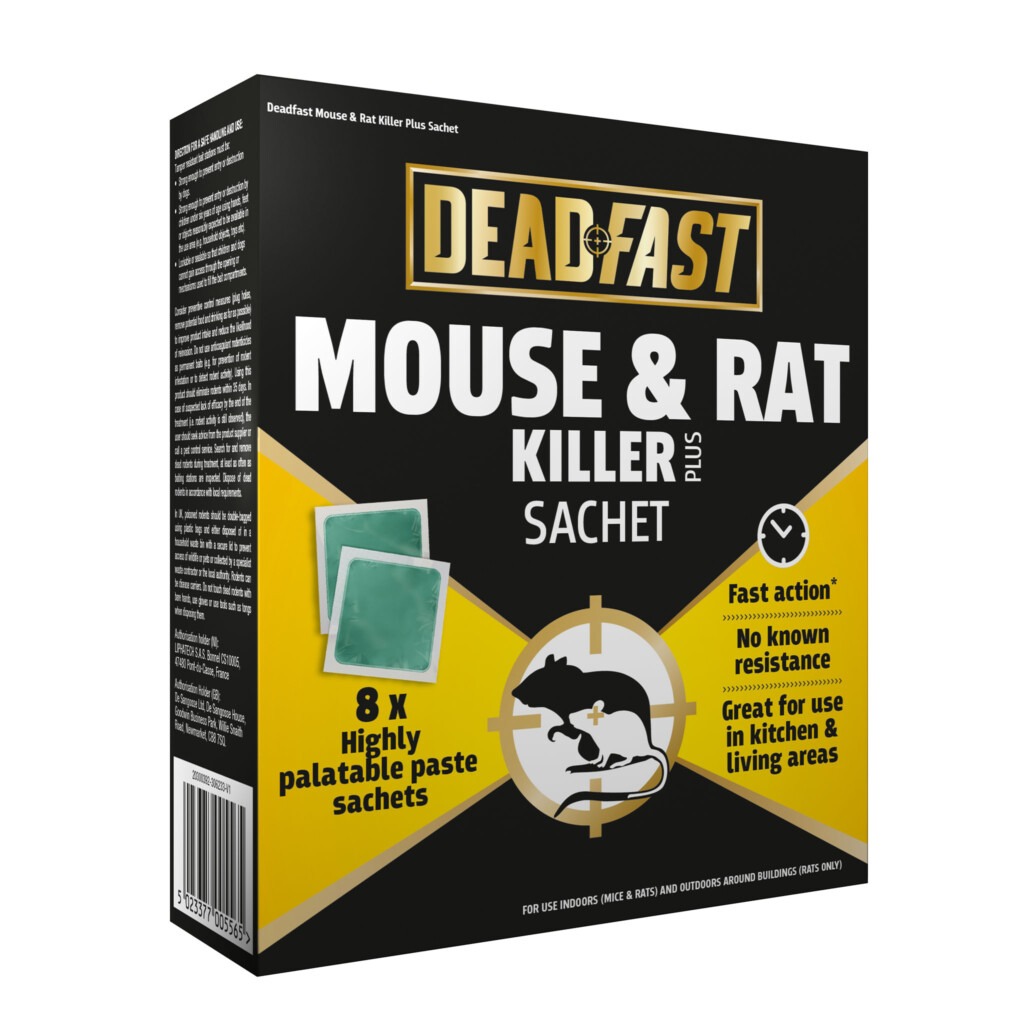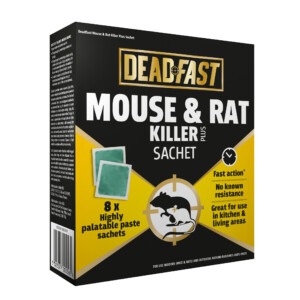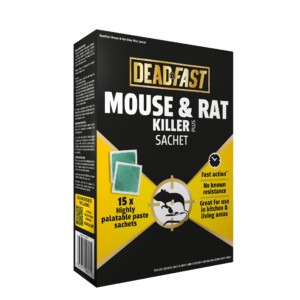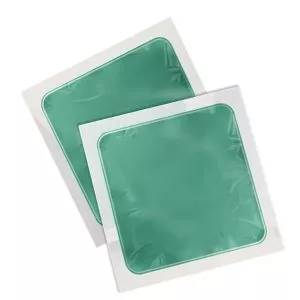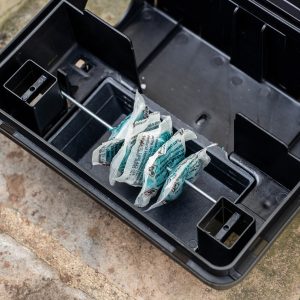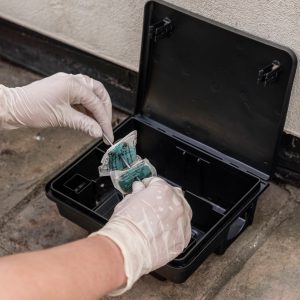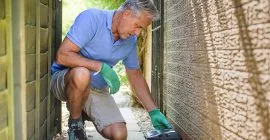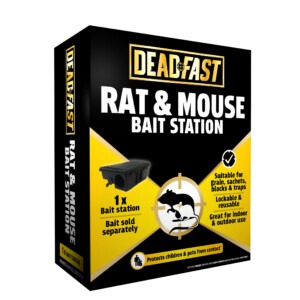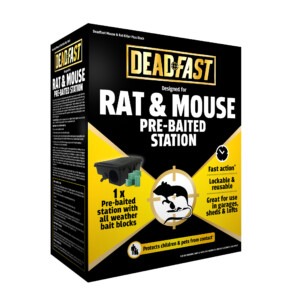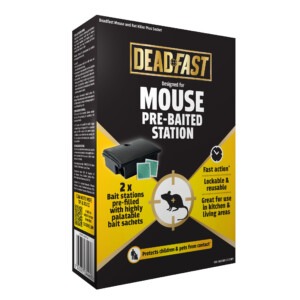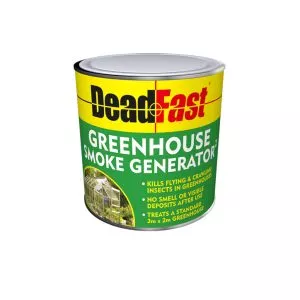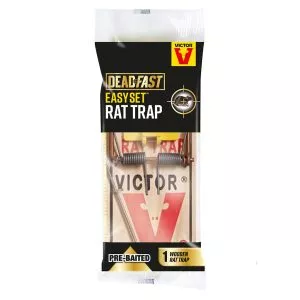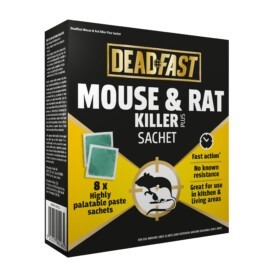Take control of rodent problems quickly and effectively with Deadfast Mouse & Rat Killer Plus Sachets. Designed for use in kitchens and living areas, these sachets deliver fast results in just one feed.
The ready to use soft paste formulation is highly palatable, making it irresistible to mice and rats even when other food sources are available. Each sachet contains the latest active ingredient with no known resistance, ensuring maximum effectiveness.
For safety, use the sachets with a tamper-resistant bait station to keep them secure and out of reach of children and pets.
- Fast action*
- Highly palatable
- Lethal dose in just one feed
- Convenient, ready-to-use soft paste formulation
- Clean and low-fat release for minimal mess
- Suitable for indoor use (mice and rats) and outdoor use around buildings (rats only)
- Find out more about our Deadfast range
*Due to their delayed mode of action, anticoagulant rodenticides take from 4 to 10 days to be effective after consumption of the bait.
Sizes available
- 8 x 10g Paste Sachets
- 15 x 10g Paste Sachets
- Product Details
- How to Use
- Tips & Advice
- Safety Information
Why Use
- Deadfast Mouse & Rat Killer Plus Sachets contains Difethialone. This is the most advanced and effective active ingredient on the market, presenting no known resistance in rodents.
- It has been developed to be effective at only 25ppm to ensure rodents consume a lethal dose the first time, making this bait ideal even for high infestations
- The soft paste bait formulation has the highest palatability for enhanced performance. It outcompetes any processed, stored or prepared food.
Deadfast Mouse & Rat Killer Plus Sachets contain Difethialone. Use Biocides safely. Always read the label and product information before use.
How to Use
General Advice
- To avoid risks to human health and the environment comply with the instructions for use
- Do not breathe dust
- Do not eat, drink or smoke when using this product
- Avoid release to the environment
- Wear protective gloves when handling
- Prevent access to bait by children, birds and non-target animals (particularly dogs, cats, pigs and poultry)
- Baits must be securely placed in a way so as to minimise the risk of consumption by other animals or children Where possible, secure baits so they can not be dragged away
- Search for and remove dead rodents at frequent intervals during treatment, at least as often as when baits are checked and/or replenished
- Daily inspection may be required in some circumstances
- Wash hands and exposed skin before meals and after use
- Keep in a cool, dry, well-ventilated place
- Store only in original container
Frequently Asked Questions
Q: Why is the bait in sachets? Do I need to remove the sachets?
A: There has been a recent change in the law on how rodenticides can be sold. They must not be sold loose. The sachets have tiny (impossible to see) perforations that allow rodents to smell and be attracted to the food. The bait is very palatable to rodents and they will happily chew through the sachets to get at the contents
Q: How long does it take to kill the rodents? Is one feed enough?
A: Rodents can be killed with just one feed. After 3-8 days any rodents that have consumed the bait will be controlled. The active ingredient interferes with an enzyme production affecting their ability to clot blood
Q: How would I dispose of any dead rodents?
A: Whilst wearing gloves remove dead rodents and place them in a double bag, put this bag into a secure household refuse bin.
For any questions or advice, please contact our technical advice line on 01480 443789 (Mon-Fri 10am-4pm) or email customerservice@westlandhorticulture.com
DIRECTION FOR A SAFE HANDLING AND USE:
Tamper resistant bait stations must be:
• Strong enough to prevent entry or destruction by dogs.
• Strong enough to prevent entry or destruction by children under six years of age using hands, feet or objects reasonably expected to be available in the use area (e.g. household objects, toys etc).
• Lockable or sealable so that children and dogs cannot gain access through the opening or mechanisms used to fill the bait compartments.
Consider preventive control measures (plug holes, remove potential food and drinking as far as possible) to improve product intake and reduce the likelihood of reinvasion. Do not use anticoagulant rodenticides as permanent baits (e.g. for prevention of rodent infestation or to detect rodent activity). Using this product should eliminate rodents within 35 days. In case of suspected lack of efficacy by the end of the treatment (i.e. rodent activity is still observed), the user should seek advice from the product supplier or
call a pest control service. Search for and remove dead rodents during treatment, at least as often as baiting stations are inspected. Dispose of dead rodents in accordance with local requirements. In UK, poisoned rodents should be double-bagged using plastic bags and either disposed of in a household waste bin with a secure lid to prevent access of wildlife or pets or collected by a specialist waste contractor or the local authority. Rodents can be disease carriers. Do not touch dead rodents with bare hands, use gloves or use tools such as tongs when disposing them.
FIRST AID INSTRUCTIONS
This product contains an anticoagulant substance. If ingested, symptoms, which may be delayed, may include nosebleeds and bleeding gums. In severe cases, there may be bruising and blood present in the faeces or urine. Antidote: Vitamin K1 administered by medical/
veterinary personnel only.
In case of:
• Dermal exposure, wash skin with water and then with water and soap.
• Eye exposure, rinse eyes with eye-rinse liquid or water, keep eye lids open at least 10 minutes.
• Oral exposure: Rinse mouth carefully with water. Never give anything by mouth to an unconscious person. Do not provoke vomiting. If swallowed, seek medical advice immediately and show the product container or label.
UK medical professionals should contact the National Poisons Information Service (www.npis.org) for further advice. Contact a veterinary surgeon in case of ingestion by a pet.
DIRECTIONS FOR DISPOSAL
At the end of the treatment, dispose of any uneaten bait and packaging in accordance with local regulations. In the UK, waste bait should be double-bagged in plastic bags and disposed of in a household waste bin with a secure lid to prevent access by wildlife or pets, or taken to a civic amenity site. For information on civic amenity sites, contact the local authority.
STORAGE INSTRUCTIONS
Store in a dry, cool, and well-ventilated place. Keep the container closed and away from direct sunlight. Store in places prevented from accessible to children, birds, pets, and farm animals.


